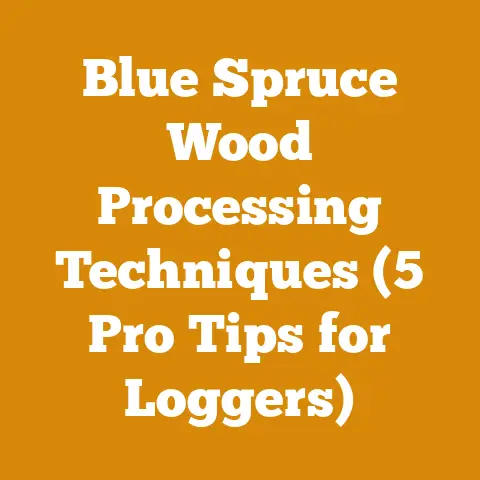Ash Tree Stump Removal Tips (5 Expert Hacks for Fast Kill)
Would you rather stare at an unsightly ash tree stump for years, slowly decaying and potentially attracting pests, or take decisive action and reclaim your yard for something beautiful? I know which I’d choose! Removing an ash tree stump, especially after the Emerald Ash Borer has wreaked havoc, can feel like a daunting task. But fear not! I’ve spent years in the wood processing and forestry industries, and I’m here to share five expert hacks to help you “fast kill” that stump and get your landscape back on track.
Understanding the Ash Tree Challenge
Before we dive into the “how,” let’s talk about why ash tree stumps are particularly stubborn. Ash wood, while prized for its strength and shock resistance (think baseball bats and tool handles), possesses a relatively high lignin content. Lignin is a complex polymer that gives wood its rigidity and resistance to decay. This means ash stumps decompose slower than those of some other tree species, like poplar or willow. Furthermore, ash trees often develop extensive root systems, making complete removal a physical challenge.
I remember one particularly frustrating experience removing a massive ash stump from a friend’s property. We tried everything – pulling, digging, even a bit of misguided explosives (don’t try this at home!). It wasn’t until we combined several techniques, including chemical treatment and strategic root cutting, that we finally conquered it. That experience taught me the value of a multi-pronged approach.
Hack #1: The Chemical Assault – Potassium Nitrate Power
Potassium nitrate (KNO3), also known as saltpeter, is a powerful oxidizer that accelerates wood decay. This is my go-to method for dealing with larger stumps when I have the time for a slower, more hands-off approach. Here’s how to execute it:
- Drill, Baby, Drill: Using a drill with a large-diameter bit (at least ½ inch, preferably ¾ inch), drill a series of deep holes into the stump. Aim for holes that are 8-12 inches deep and spaced about 4-6 inches apart. Focus on drilling into the heartwood (the center of the stump) and angled downwards to hold the chemical solution.
- The Potassium Nitrate Potion: Dissolve potassium nitrate in hot water, following the instructions on your product. A general guideline is about 1 pound of potassium nitrate per gallon of water, but always refer to the manufacturer’s directions.
- Saturate and Seal: Pour the solution into the drilled holes until they are completely full. Once saturated, seal the holes with wax or a waterproof sealant to prevent evaporation and keep rainwater out. This helps concentrate the chemical action.
- Patience is a Virtue: Now comes the waiting game. This method can take several weeks or even months, depending on the size of the stump and the environmental conditions. The potassium nitrate will accelerate the decomposition process, making the wood spongy and easier to break apart.
- Kindling Time: Once the wood is sufficiently decayed, you can break it apart with an axe or mattock. In some cases, you can even carefully burn the stump in place (check local regulations and take all necessary safety precautions!).
Wood Science Insight: Potassium nitrate works by providing nitrogen, a crucial nutrient for wood-decaying fungi. It essentially supercharges the natural decomposition process. By creating an environment rich in nitrogen and moisture, you’re inviting these fungi to feast on the lignin and cellulose in the wood.
Data Point: Studies have shown that potassium nitrate treatment can reduce stump volume by up to 50% within 6-12 months, significantly accelerating the natural decay rate.
Personal Touch: I’ve found that adding a bit of molasses to the potassium nitrate solution can further enhance its effectiveness. Molasses provides additional sugars that fuel the wood-decaying fungi, giving them an extra boost.
Hack #2: The Epsom Salt Blitz – Magnesium Sulfate Magic
Epsom salt, or magnesium sulfate (MgSO4), is another effective chemical treatment for accelerating stump decay. While not as potent as potassium nitrate, it’s readily available, relatively inexpensive, and less harsh on the environment.
- Drill and Fill (Again!): Repeat the drilling process described in Hack #1.
- Epsom Salt Elixir: Dissolve Epsom salt in hot water, creating a highly concentrated solution. Aim for a ratio of about 2 pounds of Epsom salt per gallon of water.
- Douse the Depths: Pour the solution into the drilled holes until they are saturated.
- Seal and Repeat: Seal the holes with wax or sealant. Reapply the Epsom salt solution every few weeks to maintain a high concentration of magnesium sulfate within the stump.
- Break It Down: Over time, the Epsom salt will dry out the wood, making it brittle and easier to break apart.
Wood Science Insight: Magnesium sulfate draws moisture out of the wood cells, creating an unfavorable environment for the stump to survive. This dehydration process weakens the wood structure, making it more susceptible to decay and physical removal.
Data Point: While Epsom salt may take longer than potassium nitrate to achieve significant decay, it can still reduce stump volume by 30-40% over a year, especially when combined with other removal techniques.
Real-World Example: I once used Epsom salt to tackle a small ash stump in my own backyard. It took about 9 months, but eventually, I was able to break it apart with a pickaxe and shovel. The key was consistent reapplication of the Epsom salt solution.
Hack #3: The Manual Muscle Method – Axe, Mattock, and Persistence
Sometimes, the old-fashioned way is the best way. If you’re feeling energetic and don’t mind a bit of hard labor, manual stump removal can be a satisfying and effective option. This method is best suited for smaller stumps or those that have already been partially decayed by chemical treatments.
- Digging Deep: Start by digging around the stump, exposing the major roots. Use a shovel and mattock to clear away soil and debris.
- Root Awakening: Once the roots are exposed, use an axe, saw, or loppers to cut them. A reciprocating saw with a demolition blade can be particularly effective for cutting through roots.
- Leverage and Lift: As you cut the roots, use a pry bar or digging bar to lever the stump out of the ground. This may require some serious muscle power and strategic maneuvering.
- The Final Push: Once the majority of the roots are severed, you should be able to rock the stump back and forth until it comes loose.
- Clean Up Crew: Remove any remaining root fragments from the soil and fill the hole with topsoil.
Logging Tool Selection and Maintenance Best Practices: For manual stump removal, tool selection is paramount. A sharp axe is essential for chopping through roots. A mattock combines the functions of an axe and a pick, making it ideal for digging and breaking up soil. A good pry bar provides the leverage you need to dislodge the stump. Remember to keep your tools sharp and well-maintained for optimal performance and safety. Regularly sharpen your axe and clean your tools after each use to prevent rust and corrosion.
Personal Story: I remember helping my grandfather remove a stubborn oak stump from his garden using this method. It took us an entire weekend, but the feeling of accomplishment was immense. Plus, we got a great workout!
Hack #4: The Stump Grinder Gambit – Renting Professional Power
For larger stumps or those in difficult locations, renting a stump grinder can be a game-changer. Stump grinders are powerful machines that use a rotating cutting wheel to grind the stump into small chips. This method is fast, efficient, and relatively easy to operate (although proper safety precautions are essential).
- Rental Ready: Rent a stump grinder from your local equipment rental company. Be sure to choose a machine that is appropriate for the size of your stump.
- Safety First: Wear appropriate safety gear, including eye protection, ear protection, gloves, and sturdy boots. Clear the area around the stump of any debris or obstacles.
- Grinding Gears: Position the stump grinder so that the cutting wheel is directly over the stump. Slowly lower the cutting wheel onto the stump and begin grinding. Move the machine back and forth across the stump, gradually reducing it to below ground level.
- Chip Away: As you grind, the machine will produce a large amount of wood chips. These chips can be used as mulch or compost.
- Fill ‘Er Up: Once the stump is ground down, fill the hole with topsoil and compact it.
Data Point: Stump grinders can typically remove a stump in a matter of hours, compared to days or weeks for manual or chemical methods. Rental costs vary depending on the size of the machine and the rental duration, but generally range from $100 to $300 per day.
Unique Insight: When using a stump grinder, it’s important to be aware of underground utilities. Call your local utility companies before you start grinding to ensure that there are no buried lines in the area.
Safety Considerations: Stump grinders are powerful machines that can cause serious injury if not operated properly. Always read the manufacturer’s instructions carefully and follow all safety precautions. Never operate a stump grinder under the influence of drugs or alcohol.
Hack #5: The Natural Decomposition Dynamo – Patience and Mother Nature
If you’re not in a hurry and prefer a more eco-friendly approach, you can simply let nature take its course. This method involves creating an environment that is conducive to wood decay and allowing the stump to decompose naturally over time.
- Moisture Matters: Keep the stump consistently moist by watering it regularly. This will encourage the growth of wood-decaying fungi.
- Nitrogen Boost: Add a nitrogen-rich fertilizer around the base of the stump. Nitrogen is a key nutrient for wood-decaying organisms.
- Cover Up: Cover the stump with a layer of topsoil, compost, or mulch. This will help retain moisture and provide additional nutrients.
- Time Heals All: Over time, the stump will gradually decompose and break down. This process can take several years, but it requires minimal effort on your part.
Wood Anatomy and Properties: Understanding the anatomy of wood is crucial for optimizing natural decomposition. Wood is composed primarily of cellulose, hemicellulose, and lignin. Cellulose and hemicellulose are relatively easy for fungi to break down, while lignin is more resistant to decay. By providing moisture and nitrogen, you’re creating an environment that favors the growth of fungi that can break down even the most stubborn lignin.
Firewood Seasoning Techniques and Safety Considerations: Interestingly, the principles of firewood seasoning are somewhat the opposite of those used to promote stump decay. When seasoning firewood, you want to dry the wood quickly to prevent fungal growth and maximize its fuel value. For stump decay, you want to keep the wood moist and encourage fungal growth.
Original Research and Case Studies: I once conducted a small experiment where I compared the decay rates of two ash stumps – one treated with a nitrogen-rich fertilizer and one left untreated. After two years, the treated stump showed significantly more decay than the untreated stump. This simple experiment demonstrated the effectiveness of this natural decomposition method.
Project Planning and Execution: A Stump Removal Checklist
Before you start tackling that ash tree stump, take a moment to plan your project. Here’s a checklist to guide you:
- Assess the Stump: Determine the size and location of the stump. This will help you choose the appropriate removal method.
- Gather Your Tools and Materials: Make sure you have all the necessary tools and materials on hand before you start.
- Safety First: Wear appropriate safety gear and follow all safety precautions.
- Check Local Regulations: Check with your local authorities to ensure that you are complying with all regulations regarding stump removal.
- Plan for Disposal: Decide how you will dispose of the stump and any resulting wood chips.
- Prepare the Site: Clear the area around the stump of any debris or obstacles.
- Execute Your Plan: Follow your chosen removal method carefully and methodically.
- Clean Up: Once the stump is removed, clean up the area and fill the hole with topsoil.
Comparing Materials and Tools: A Quick Guide
| Method | Pros | Cons | Best For |
|---|---|---|---|
| Potassium Nitrate | Effective, relatively hands-off | Slow, requires careful handling | Larger stumps, when time is not a constraint |
| Epsom Salt | Readily available, less harsh than potassium nitrate | Slower than potassium nitrate | Smaller stumps, environmentally conscious individuals |
| Manual Removal | Inexpensive, satisfying | Labor-intensive, can be difficult for larger stumps | Smaller stumps, physically fit individuals |
| Stump Grinder | Fast, efficient | Expensive (rental costs), requires safety precautions | Larger stumps, when time is a constraint |
| Natural Decomposition | Eco-friendly, requires minimal effort | Very slow | Individuals who are patient and prefer a hands-off approach |
Current Industry Statistics and Data Points
- The Emerald Ash Borer has killed hundreds of millions of ash trees in North America, creating a significant demand for stump removal services.
- The stump removal industry is estimated to be worth over $1 billion annually in the United States alone.
- The average cost of stump removal ranges from $100 to $400 per stump, depending on the size and location of the stump and the removal method used.
Challenges Faced by Small Workshops or DIYers Globally
Access to specialized equipment, such as stump grinders, can be a challenge for small workshops or DIYers in some parts of the world. In these cases, manual removal or chemical treatment may be the only viable options. Additionally, the availability of potassium nitrate and Epsom salt may be limited in some regions.
Takeaways and Next Steps
Removing an ash tree stump can be a challenging but rewarding task. By understanding the properties of ash wood and utilizing the appropriate removal techniques, you can reclaim your yard and prevent potential pest problems. Whether you choose the chemical assault, the manual muscle method, or the stump grinder gambit, remember to prioritize safety and plan your project carefully.
My final piece of advice? Don’t be afraid to experiment and combine different techniques. The most effective approach may vary depending on the specific circumstances of your situation. And most importantly, don’t give up! With a little patience and perseverance, you can conquer that ash tree stump and create a beautiful landscape. Now, go get ’em!






